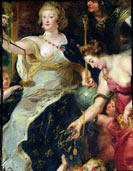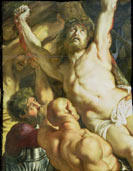Peter Paul Rubens


The work of Peter Paul Rubens, one of the most influential painters of Baroque Europe, is sometimes difficult to appreciate. Rubens' seventeenth-century visual vocabulary for artistic message-making, classical mythology and allegory, is a foreign language to most. His frolicking, chubby women, often ludicrously naked, displaying cellulite and all, embarrass us: their largeness is an anathema to the iconic female slenderness we now surround ourselves with. The sheer busy-ness of Rubens' paintings, and the exaggerated expressions and poses of his characters seem theatrical, contrived and even melodramatic. The nuances of the diplomatic niceties in his epic royal commissions aren't easily decipherable without knowledge of the historical context; nowadays we aren't susceptible to the religious fervour his passionate biblical evocations were designed to provoke. Rubens' overt ambition and self-promotion, and his business-like approach to his art, make him seem somewhat unappealingly immodest and prosaic to us, too. Our idea of an artistic genius isn't confirmed by the fact that Rubens' assistants did much of the painting. Rubens, despite the deep appreciation of his work by generations of painters, hasn't really enjoyed overwhelming popular appeal or fashionable status, perhaps for these reasons. Possibly we find it easiest to see something of Rubens' artistic greatness in his most personal and direct paintings, in his late landscapes and his vivid and sensitive portraits of his family. Rubens was born in 1577 into a turbulent Europe, deeply divided by the religious and political strife which was to dominate his life and work. Rubens' early years mirrored this conflict; his family lived first as Protestant refugees in Cologne, then converted to Catholicism; Rubens lived from the age of ten in Antwerp, in the Spanish Netherlands, under a Catholic Spanish government. Rubens' excellent education had given him an avid interest in Classical art, literature and thought, and after training as a painter, he travelled to Italy in 1600 to experience both Classical and Italian Renaissance art at first hand. His appointment as court painter to the Duke of Mantua allowed him to visit Venice, Genoa and Rome. There he studied and drew Classical sculpture obsessively and saw and copied work by other Italian artists, particularly Michelangelo and Caravaggio. In 1603, Rubens visited Spain on a diplomatic mission to Philip III, and discovered Titian's paintings, later to become so important to his subtle use of colour, in the Royal Collection in Madrid. Rubens returned to Antwerp in 1608. His Italian experience had enhanced his Northern European realism with a new awareness of drawing the human form in a monumental way (from studying Classical sculpture and Michelangelo) and creating dynamic compositions with light, shade, and colour (from Caravaggio and Titian). The Twelve Years' Truce between Spain and the Northern Netherlands in 1609 brought the Southern Netherlands peace, stability and economic optimism, and the Catholic Spanish governors in Brussels, Archduke Albert and Archduchess Isabella, enthusiastic patrons of the arts, appointed Rubens their court painter, allowing him to live in Antwerp. The Counter-Reformation movement to restore Catholicism to Protestant and Calvinist Northern Europe, actively supported by the Spanish rulers in the Southern Netherlands, needed persuasive, heroic visual imagery that expressed and inspired powerful, religious feeling. These circumstances provided an ideal setting for Rubens' talent. The success of early works like the powerful and emotionally compelling altarpiece The Raising of the Cross, painted for Antwerp cathedral in 1610-11, brought commissions for religious works from all over Catholic Europe. Rubens directed the largest and most successful artistic workshop in Northern Europe; his many studio assistants, who included the famous portraitist Anthony Van Dyck, were desperate for the chance to work with a painter of Rubens' artistic stature. Rubens complained to a friend, "I can tell you truly, without exaggeration, that I have had to refuse over one hundred, even some of my own relatives or my wife's, and not without causing great displeasure among many of my own best friends." Running his studio as a highly efficient commercial enterprise, with a scale of prices depending on how much of the work Rubens had actually painted, enabled him to keep pace with the enormous demand for his painting. Rubens' reputation meant he was summoned to provide grand decorative paintings for the royal courts of Europe, celebrating their monarchs' power and summing up their achievements. Rubens said himself, with characteristic self-confidence: "I confess that I am, by natural instinct, better fitted to execute very large works than small curiosities. . my talent is such that no undertaking, however vast in size or diversified in subject, has ever surpassed my courage." The subjects of these major projects were clothed in the visual conventions of Classical myth and allegory. In his cycle of paintings in the Luxembourg Palace, celebrating the life and reign of Marie de Medici, Regent of France, this artistic device enabled Rubens to negotiate elegantly the most dangerous diplomatic minefield - the sensitive political situation both within the French court itself and between France and its European neighbours.Rubens cherished his status as a gentleman that artistic fame and prestige brought him, and during the 1620s developed a significant role in international politics during the Thirty Years' War. The Archduchess Isabella trusted Rubens and appreciated his integrity, cultivated demeanour and social skills (Rubens was also fluent in five languages). In 1623 she involved him in the search for a diplomatic solution to the conflict which had resumed between Spain and the Northern Netherlands. Rubens believed passionately in the cause of European peace, and travelled on secret missions to the Northern Netherlands and official diplomatic visits to the courts of England and Spain, where he met and worked with the Spanish painter Velazquez. Although he helped to bring about political agreement between England and Spain (he was knighted by both Charles I and Philip IV), Rubens eventually became disillusioned, snubbed by aristocratic courtiers and unconvinced about his usefulness as an ambassador for peace, and returned to Antwerp and family life at the beginning of the 1630s. Rubens' second wife, Helene Fourment, only 16 when they married in 1630, was a source of inspiration to Rubens in the last ten years of his life. She appeared in many of his later mythological scenes, including The Three Graces, and some amazingly intimate and affectionate portraits such as Helene Fourment in a Fur Wrap. Another artistic stimulus for Rubens was the landscape around his country estate, Het Steen, in the Brabant countryside. Rubens painted here very much for his own pleasure, rather than to promote his artistic career. Painting of rural scenes was very much a part of the artistic heritage of the Netherlands; Rubens' sensitive and technically brilliant landscape paintings of the 1630s foreshadowed the work of later landscape artists, particularly Gainsborough and Constable. Rubens died in 1640, one the most celebrated, versatile high achievers in Northern Europe. His output had been enormous, and all-encompassing in subject matter. His epitaph reads: "Peter Paul Rubens, knight?Lord of Steen, who, among the other gifts by which he marvellously excelled in the knowledge of ancient history and all other useful and elegant arts, deserved to called the Apelles, not only of his own age but of all time, and made himself a pathway to the friendship of kings and princes." Looking closer, with an awareness of the artistic conventions of his time, we can see that Rubens' painting actually celebrates life writ large. His painting epitomized the Baroque spirit in art. Realistically conceived figures in a new kind of space which reaches out towards us, out of the picture frame, and the rhythm of light and dark and expressive colour created profoundly affecting images which reflected the "passions of the soul". That was what his patrons expected, and what the Catholic Church, and the royalty of Europe, needed for their propaganda purposes. The visual images of ecstasy and violent feeling that sometimes seem to us stagey and overstated, were essential to the paintings' purpose. Our difficulty with these powerful displays of emotion is that today the spiritual in art is more often about serene, meditative visions - and we don't accord the monarchy the divine status that Rubens and his contemporaries took for granted. Kenneth Clark wrote that Rubens "takes the female body, the plump, comfortable, clothed, female body of the North, and transforms it imaginatively with less sacrifice of its carnal reality than had ever been necessary before. He creates a new, complete race of women." However unfashionably difficult their heftiness, the "carnal reality" of Rubens' female nudes reveals to us his most virtuoso handling of oil paint and his humanistic ideals. TheThree Graces convince us of their solid humanity in their monumentality, and the unidealized, down-to-earth, workaday femininity of Helene in her fur wrap, echoed often in the paintings of his Dutch contemporary, Rembrandt, indicates both Rubens' supreme mastery of subtle colour and his love for his young wife. For Rubens, too, the exuberantly ample female form, which conformed entirely with seventeenth century ideals of beauty in Northern Europe, was connected with fertility, abundance and above all the idea of peace, which he pursued throughout his life. Reconciling ourselves to the overwhelming effect of Rubens' nudes enables to see his real artistic genius. Rubens' influence was crucial to 18th century French painting - Watteau and Boucher's ebullient, graceful Rococo nudes develop from Rubens' engaging female forms. The Romantic painter Delacroix admired the energy and vitality of Rubens' fluency with paint, writing "He dominates, he overwhelms you with so much liberty and audacity." Renoir was surely looking backwards to Rubens' female forms for his monumental "Bathers". Perhaps a postscript to the story of Rubens' epic nudes might involve the contemporary artist Lucian Freud's candid investigation of massive female form.

0 Comments:
Post a Comment
<< Home